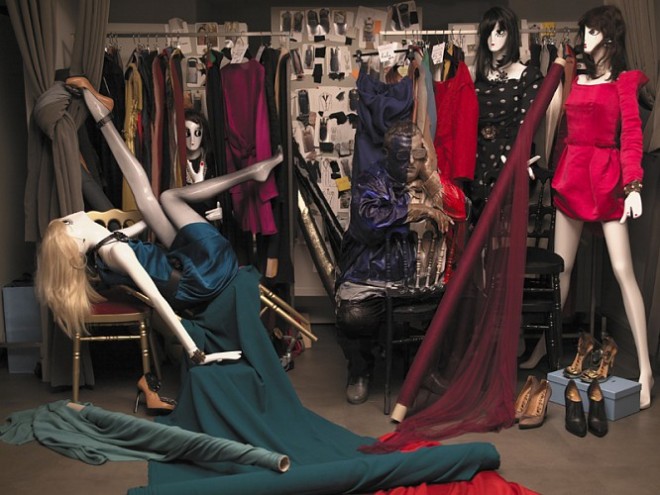a conversation with Daniel Ho, Gu Ling, Chris Moore
Liu Bolin: Lost in Art,” solo exhibition by Liu Bolin.
Eli Klein Fine Art (462 West Broadway, between Houston and Prince, New York). Mar 20 – May 11, 2012.
Chris Moore: Like Cindy Sherman, Liu Bolin’s photography largely uses rather than portrays himself but whereas Sherman’s work is about the characters caught in the strangeness of an unanchored moment, Liu’s are all about someone, often himself, being subsumed into a place, whether a policeman, a political banner, a polluted river, or Mao’s portrait above the Tiananmen Gate in Beijing.
Daniel Ho: Liu is becoming a meme more than anything. I guess it is rooted in the visual trickery or illusion that stretches to the origins of photography (if not further to trompe l’oeil and discovery of perspective itself) and highlights this artifice.
Gu Ling: I think his practice initiates from the “action” itself rather than photography. He paints himself and merges into the environment, role-playing, one after another, according to the surroundings. In some interviews, Liu said he was considered a nobody and often ignored by others. This became the motivation for him to deal with this ignorance directly, making himself “invisible” and leading people to reflect whether it’s the environment that is at fault or is it they themselves. In the exhibition “Lost in Art,” he co-operated with the fashion masters in the same way, action or performance art rather than simply photography.

Photograph, 46 1/2 x 59 inches (118 x 150 cm), 2011
CM: What about the fashion link? I like the “all-over” effect of the “trade-mark” Gaultier Breton fisherman shirts.
DH: Really it’s just a proliferation of an art brand, which lends doubtful cultural value to brands eager to burnish their credibility in the noble aim of selling more handbags and scarves to a billion Chinese.
CM: I think it’s more complex than that. Gaultier is perhaps the most famous “insider-outsider” in fashion, even more so than Vivienne Westward — so why Gaultier instead of frankly almost any other designer or fashion house? There’s real bite here, even if teasing — which I’m sure Gaultier appreciates – and it is fun, including with it’s very “virality.”

Photograph ,57 1/2 x 78 3/4 inches (146 x 200 cm), 2011
DH: I’m holding back my gag reflex with this whole fashion thing. I suppose there is arguably a subversive element to his work. Just because his “Hiding in the City” series has gone viral doesn’t mean it’s bad. It probably is designed to go viral, but it’s a bit of a one-liner, at least on first sight.
CM: What about on second sight? Surely repetition is the point here — always the same passive pose — individual “passivity” in Chinese art is a topic worth special attention, starting with Zeng Fanzhi.
DH: One could say the invisibility of the people speaks to a certain powerlessness, which in the West perhaps is read as the “lost individual” in the “collectivity” of the Chinese anthill. And to show powerlessness like that is at least a bit subversive.

Photograph, 46 1/2 x 59 inches (118 x 150 cm), 2011
CM: How?
DH: By drawing attention to what seems invisible.
GL: American artist Alexa Meade paints on people’s bodies to turn the physical into a two-dimensional image. The transition between the painted surface and its surroundings is striking. It’s the same method but has exactly the opposite effect. Desiree Palmen, a Dutch artist, also used the Meade approach, which is similar to Liu, but doesn’t rely on painting. She uses tailor-made costumes and even dolls which are meant to be “fake companions.”
CM: Anything else?
DH: The “Where’s Waldo?” quality to it. The apparent merging of the human and the backdrop under the machine vision of the camera — oh, wait, that’s nothing new….
GL: For me the method itself sounds a bit childish and funny, like Daniel mentioned, the “Where’s Waldo” quality; but it also carries a kind of shared child-like wish to be transparent, so we can’t be seen by others. It’s like a kind of “super power” and Liu has realized it through art.
CM: I think it raises specific questions to do with the temporal and spatial relationship between photography and performance. Asking “where am I now?” begs the question “Why?”
(All images courtesy of Eli Klein Fine Art and Liu Bolin)